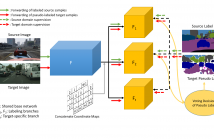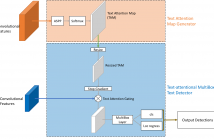
This paper presents a framework for accurately tracking objects of complex shapes with joint minimization of geometric and photometric parameters using a coarse 3D object model with the RGB-D cameras. Tracking with coarse 3D model is remarkably useful for industrial applications. A technique is proposed that uses a combination of point-to-plane distance minimization and photometric error minimization to track objects accurately. The concept of 'keyframes' are used in this system of object tracking for minimizing drift.
- Categories:
 18 Views
18 Views
- Read more about A Fully Convolutional Tri-branch Network (FCTN) For Domain Adaptation
- Log in to post comments
A domain adaptation method for urban scene segmentation is proposed in this work. We develop a fully convolutional tri-branch network, where two branches assign pseudo labels to images in the unlabeled target domain while the third branch is trained with supervision based on images in the pseudo-labeled target domain. The re-labeling and re-training processes alternate. With this design, the tri-branch network learns target-specific discriminative representations progressively and, as a result, the cross-domain capability of the segmenter improves.
- Categories:
 16 Views
16 Views
- Read more about Efficient Segmentation-Aided Text Detection for Intelligent Robots_Slides
- Log in to post comments
Scene text detection is a critical prerequisite for many fascinating applications for vision-based intelligent robots. Existing methods detect texts either using the local information only or casting it as a semantic segmentation problem. They tend to produce a large number of false alarms or cannot separate individual words accurately. In this work, we present an elegant segmentation-aided text detection solution that predicts the word-level bounding boxes using an end-to-end trainable deep convolutional neural network.
- Categories:
 9 Views
9 Views- Read more about Efficient Segmentation-Aided Text Detection for Intelligent Robots_Poster
- Log in to post comments
Scene text detection is a critical prerequisite for many fascinating applications for vision-based intelligent robots. Existing methods detect texts either using the local information only or casting it as a semantic segmentation problem. They tend to produce a large number of false alarms or cannot separate individual words accurately. In this work, we present an elegant segmentation-aided text detection solution that predicts the word-level bounding boxes using an end-to-end trainable deep convolutional neural network.
- Categories:
 8 Views
8 Views
- Read more about Discriminant Correlation Analysis for Feature Level Fusion with Application to Multimodal Biometrics
- Log in to post comments
In this paper, we present Discriminant Correlation Analysis (DCA), a feature level fusion technique that incorporates the class associations in correlation analysis of the feature sets. DCA performs an effective feature fusion by maximizing the pair-wise correlations across the two feature sets, and at the same time, eliminating the between-class correlations and restricting the correlations to be within classes.
- Categories:
 120 Views
120 Views